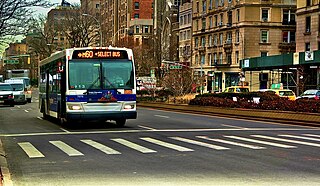
The Port Authority of New York and New Jersey, is a joint venture between the U.S. states of New York and New Jersey, established in 1921 through an interstate compact authorized by the United States Congress. The Port Authority oversees much of the regional transportation infrastructure, including bridges, tunnels, airports, and seaports, within the geographical jurisdiction of the Port of New York and New Jersey. This 1,500-square-mile (3,900 km2) port district is generally encompassed within a 25-mile (40 km) radius of the Statue of Liberty National Monument. The Port Authority is headquartered at 4 World Trade Center in Lower Manhattan.

John F. Kennedy International Airport is a major international airport serving New York City and the New York metropolitan area, in the United States. The airport is the busiest of the seven airports in the New York airport system, the 6th-busiest airport in the United States, and the busiest international air passenger gateway into North America. The facility covers 5,200 acres (2,104 ha) and is the largest and busiest airport in the New York City area.

Newark Liberty International Airport is an international airport straddling the boundary between the cities of Newark in Essex County and Elizabeth in Union County, New Jersey, in the United States. Located about 4.5 miles (7.2 km) south of downtown Newark and 9 miles (14 km) west-southwest of Manhattan in New York City, it is a major gateway to points in Europe, South America, Asia, and Oceania. It is jointly owned by the cities and leased to its operator, the Port Authority of New York and New Jersey. It is the second-busiest airport in the New York airport system behind John F. Kennedy International Airport but far ahead of LaGuardia Airport.

LaGuardia Airport is a civil airport in East Elmhurst, Queens, New York City. Covering 680 acres (280 ha) as of January 1, 2024, the facility was established in 1929 and began operating as a public airport in 1939. It is named after former New York City mayor Fiorello La Guardia.

Long Island MacArthur Airport, formerly known as Islip Airport, is a public airport in Ronkonkoma, in the Town of Islip, in Suffolk County, on Long Island, New York, United States. Covering 1,311 acres (531 ha), the airport was established in 1942 and began serving as a commercial airport in 1960. It has three runways and two helipads.

Buffalo Niagara International Airport is in Cheektowaga, New York, United States. The airport serves Buffalo, New York and Niagara Falls, New York United States, and the southern Golden Horseshoe region of Ontario, Canada. It is the third-busiest airport in the state of New York and the busiest inside of the Buffalo-Niagara Falls metropolitan area. It is about 11 miles (18 km) east of Downtown Buffalo and 60 miles (97 km) southeast of Toronto. The airport covers 1,000 acres (400 ha).

Teterboro Airport is a general aviation relief airport in the boroughs of Teterboro, Moonachie, and Hasbrouck Heights in Bergen County, New Jersey. It is owned and managed by the Port Authority of New York and New Jersey and operated by AFCO AvPORTS Management. The airport is in the New Jersey Meadowlands, 12 miles (19 km) from Midtown Manhattan, which makes it popular for private and corporate aircraft. The airport has a weight limit of 100,000 pounds (45,000 kg) on aircraft, making it nonviable for commercial service.

The Port Authority Bus Terminal is a bus terminal located in Manhattan in New York City. It is the busiest bus terminal in the world by volume of traffic, serving about 8,000 buses and 225,000 people on an average weekday and more than 65 million people a year.

The Marine Air Terminal is an airport terminal located at LaGuardia Airport in Queens, New York City. Its main building, designed in the Art Deco style by William Delano of the firm Delano & Aldrich, opened in 1940. The terminal was built to handle Pan Am's fleet of flying boats, the Boeing 314 Clippers, which landed on the nearby Bowery Bay. Technological advances after World War II made the Clippers obsolete, and the Marine Air Terminal was renovated in 1946 to serve conventional planes. As of April 2024, the terminal is used by Spirit Airlines for flights to various destinations around the US.
New York Airways was an American helicopter airline in the New York City area, founded in 1949 as a mail and cargo carrier. On 9 July 1953 it may have been the first scheduled helicopter airline to carry passengers in the United States, with headquarters at LaGuardia Airport. Although primarily a helicopter airline operator with scheduled passenger operations, New York Airways also flew fixed wing aircraft, such as the de Havilland Canada DHC-6 Twin Otter 19-passenger STOL twin turboprop aircraft.

The transportation system of New York City is a network of complex infrastructural systems. New York City, being the most populous city in the United States, has a transportation system which includes one of the largest and busiest subway systems in the world; the world's first mechanically ventilated vehicular tunnel; and an aerial tramway. New York City is home to an extensive bus system in each of the five boroughs; citywide and Staten Island ferry systems; and numerous yellow taxis and boro taxis throughout the city. Private cars are less used compared to other cities in the rest of the United States.

The M60 Select Bus Service is a bus route in New York City. It is part of MTA Regional Bus Operations, operated by the Manhattan and Bronx Surface Transit Operating Authority (MaBSTOA) under the New York City Transit brand. The M60 provides service between the Upper West Side of Manhattan and LaGuardia Airport in East Elmhurst, Queens, traveling between boroughs via the RFK-Triborough Bridge. It is the only direct public transit option between Manhattan and LaGuardia Airport.

Transportation in New York City has ranged from strong Dutch authority in the 17th century, expansionism during the industrial era in the 19th century and half of the 20th century, to cronyism during the Robert Moses era. The shape of New York City's transportation system changed as the city did, and the result is an expansive modern-day system of industrial-era infrastructure. New York City, being the most populous city in the United States, has a transportation system which includes one of the largest subway systems in the world; the world's first mechanically ventilated vehicular tunnel; and an aerial tramway.

Transportation in New Jersey utilizes a combination of road, rail, air, and water modes. New Jersey is situated between Philadelphia and New York City, two major metropolitan centers of the Boston-Washington megalopolis, making it a regional corridor for transportation. As a result, New Jersey's freeways carry high volumes of interstate traffic and products. The main thoroughfare for long distance travel is the New Jersey Turnpike, the nation's fifth-busiest toll road. The Garden State Parkway connects the state's densely populated north to its southern shore region. New Jersey has the 4th smallest area of U.S. states, but its population density of 1,196 persons per sq. mi causes congestion to be a major issue for motorists.

Trenton–Mercer Airport is a county-owned, joint civil–military, public airport located four miles northwest of Trenton in the West Trenton section of Ewing Township, Mercer County, New Jersey. Formerly known as Mercer County Airport, the airport serves one scheduled airline plus general and corporate aviation. The U.S. Department of Transportation reports that approximately 301,000 passengers arrived and 300,000 departed at the airport in the 12 months ending July 2023, for a total of 601,000 passengers.

The New York metropolitan area has the busiest airport system in the United States and the second busiest in the world after London. It is also the most frequently used port of entry and departure for international flights. In 2011, more than 104 million passengers used the airports under the auspices of the Port Authority of New York and New Jersey (PANYNJ). The number increased to 117 million in 2014.

The LaGuardia Link Q70 Select Bus Service bus route is a public transit line in Queens, New York City, running primarily along the Brooklyn Queens Expressway. It runs between the 61st Street–Woodside station—with transfers to the New York City Subway and Long Island Rail Road—and Terminals B and C at LaGuardia Airport, with one intermediate stop at the Jackson Heights–Roosevelt Avenue/74th Street station. This route is operated by MTA Regional Bus Operations under the MTA Bus Company brand.

The Q72 bus route constitutes a public transit route along Junction Boulevard and 94th Street in Queens, New York City. It operates between the Rego Park and East Elmhurst neighborhoods of Queens, and extends into LaGuardia Airport at the north end of the borough. It is city-operated under the MTA Bus Company brand of MTA Regional Bus Operations.
The East Side Airline Terminal was one of three air terminals in Midtown Manhattan. Opening in 1953, and occupying the full block west of 1st Avenue between 37th Street and 38th Street, the East Side Airline Terminal served as a location where passengers could purchase tickets and check baggage before boarding buses that would transport them to JFK Airport, LaGuardia Airport, or Newark Airport.
The 42nd Street Airlines Terminal, on the southwest corner of Park Avenue and 42nd Street in Midtown Manhattan, was the first of three airline terminals constructed in New York City. It was located at the site of the former Hotel Belmont. During this period of aviation, reservations, ticketing and baggage handling took place at this facility for the airlines American, Eastern, TWA, United and Pan Am. Passengers would be transferred by bus to Newark Airport, and later to the New York International Airport.

















